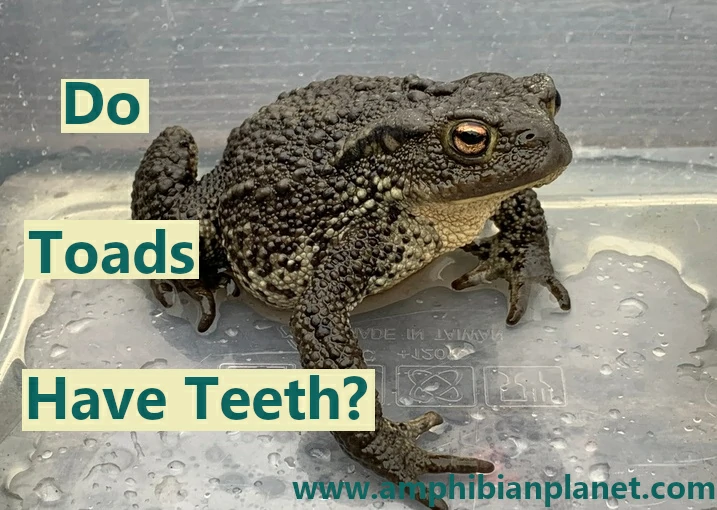Toads are intriguing creatures that attract the curiosity of many people. Many species also tend to be very secretive, so they are not frequently encountered most times of the year. Because of this, there are many misconceptions about these animals.
In general, “true toads” in the family Bufonidae do not have teeth. They are primarily ambush hunters that stun their prey, before swallowing it alive and whole. They do not need teeth to catch, hold, or eat their prey.
Many toad species, such as the American toad, actively crawl about looking for prey. When they spot an insect, worm, or any other prey small enough for them whole, they get just close enough to reach it with a quick flick of their long tongue.
They also may use their front legs in order to eat larger food. They grasp their food and push it into their mouths.
The Tadpoles of Many Toad Species Have “Beaks”
Most true toad species (Bufonidae) start their lives as fully aquatic tadpoles. Tadpoles in their early stage of development are almost completely herbivorous and eat algae, phytoplankton, and detritus.
Many tadpole species also have a “beak” and rows of denticles in their mouth that they use to scrape off the algae that grow on plants, rocks, or at the surface of the water.
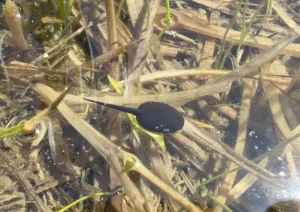
The denticles are not made of bone and enamel like our teeth are, but of keratin — a protein substance that, for instance, also makes up our fingernails and hair.
Tadpoles also have little or no tongue-like tissue and will eat by sucking the food into their throat and the food enters the long intestine where it is digested.
Due to a mostly herbivorous diet, tadpoles have very long tightly coiled intestines, that make up more than half of their body mass.
Plants contain cellulose, a compound that is very hard to digest. Because of this, plant matter needs to spend more time in the digestive system. This long intestinal tract gives tadpoles more time to break down the plant matter and absorb as many nutrients as possible.
The intestine takes up about half the space within the tadpole’s body and can be more than ten times longer than the tadpole itself.
Tadpoles Turn Into Toads
After a few months (depending on the species) the tadpoles will go through a process known as metamorphosis, in which they will transform into juvenile toads.
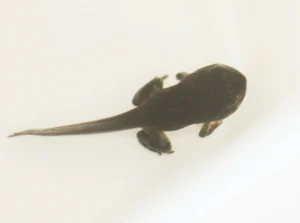
During metamorphosis, the thyroid gland secretes a growth hormone called thyroxine.
This hormone triggers the tadpoles to:
- Lose the gills, and develop lungs for breathing air
- Absorb the tail into the body
- Grow strong legs for moving on land
- Remodel other organs to form an adult toad
The tadpole’s beak is also shed, its denticles are reabsorbed and the mouth as a whole widens. In addition, the head structure also begins to change, leading to the development of a more defined jaw.
At this stage, the tadpoles of many frog species will also begin to develop true teeth. However, the tadpoles of “true toads” do not develop any teeth.
In the mouth, secretory glands develop as does a tongue, which is muscular and can be quite long. It is also very sticky.
In addition, the digestive tract shortens dramatically, and the inner lining of the remaining intestine thickens, creating many folds in the process. These folds create a very large surface for the absorption of nutrients during digestion.
As the gut shrinks, a stomach is formed that secretes pepsin – an enzyme that is important for digesting proteins found in animal-based food.
Once metamorphosis fully is complete, tiny toadlets will leave the water and live on land. These toadlets are obligate carnivores and will grow into adult toads over time.
Adult Toads Do Not Have Teeth
As earlier mentioned, toad tadpoles do not develop any teeth as they go through metamorphosis and transform into adult toads. For this reason, adult true toads have no teeth at all.
Toads are opportunistic predators and rely on their sticky tounges to catch prey. When they spot an insect (or any other prey) they get just close enough to reach it with a quick flick of their long tongue.
After catching the prey, the tongue coats it with sticky saliva. The toad will then yank its tongue back, sometimes momentarily holding the prey with its jaws, and then swallowing it whole and alive.
Some toad species may use their front legs in order to eat larger prey. They grasp their food and push it into their mouths.
Toads will eat almost any prey they can fit in their mouths. Large toad species such as Cane toads (Rhinella marina) are also known to eat mice, birds, snakes, and even other amphibians.
They swallow their prey without chewing and once swallowed, the prey travels to the stomach through the esophagus and dies in the toad’s stomach acids.
The majority of toad species are instinctively attracted to movement while hunting for food and will ignore dead bugs or other dead prey items.
However, cane toads primarily use vision, and can also use their sense of smell to find food. These toads are known to eat carrion (dead prey), and even dog food left outdoors.
Do Toads Bite?
In general, toads do not bite in the traditional sense, since they do not have any teeth. However, a toad may grab onto you with its jaws during aggressive feeding when it mistakes your hand or finger for food, or when it is being handled in a way that makes it uncomfortable and causes it stress.
A “bite” from the vast majority of toad species will usually be completely harmless. The toads’ toothless jaws would feel like a clothespin gripping onto your finger but are unlikely to penetrate your skin, or draw blood.
Frogs and toads generally do not like to be handled by humans (or anything bigger than them), so they will understandably try to defend themselves when they feel threatened.
However, they are generally not aggressive creatures. A toad will only use its toothless jaws to “bite” as a last-ditch attempt to defend itself.
Some Toad Species Have Relatively Powerful Jaws
In general, the bigger the toad, the stronger its jaws and it harder it bites. For example, a large Cane toad will have a much stronger bite than an American toad.
Large toad species such as Cane toads use their relatively powerful jaws to maintain a firm grip on mice, birds, snakes, frogs, and other large prey items, as they swallow them whole.
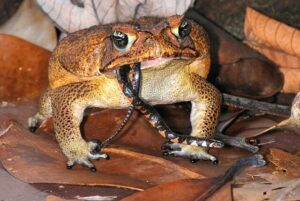
Still, even bites from large toad species are typically harmless due to the lack of teeth. It may give you a freight, but will most likely not cause serious real harm.
Can You Get Poisoned by a Bite From a Toad?
All true toads are poisonous to some degree. They have parotoid glands behind the eyes and warty glands on the skin that produce a poisonous secretion as a defense against predators.
However, although toads are poisonous, their bites are not venomous. Confused? Well, this is most likely due to a misunderstanding of the terms “venomous” and “poisonous”.
To make things simple:
- If an animal has to bite or sting you to inject its toxins, it is venomous.
- If an animal secretes its toxins outside of its body, and you absorb the toxins when you come in contact with the animal, it is poisonous.
In other words, Venom is actively injected, usually through stings, fangs, or barbs (think rattlesnakes, scorpions). Poison on the other hand is delivered much more passively and has to be absorbed/ingested into your body.
It can be ingested when it comes into contact with your eyes, lips, the mucus lining of the nose, or open cuts on your skin (think poison dart frogs).
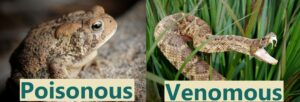
Since toads secrete their toxins on their skin, their bites are not venomous, and not toxic in any way. If you get bitten by a toad, it can not inject venom into your skin.
That said, it’s important to note that you could be harmed by a toad’s toxic secretion if it is ingested or comes in contact with your eyes and mucous membranes.
This can happen when you pick up a toad with your bare hands, then rub your eyes or stick your fingers in your nose or mouth before washing your hands – likely leading to irritation.
Sources:
American Museum of Natural History. Toothless Predator. Accessed at: https://www.amnh.org/exhibitions/frogs-a-chorus-of-colors/featured-frog-species/toothless-predator
United States Geological Survey. Larvae and Tadpole Mouthparts (PDF).

